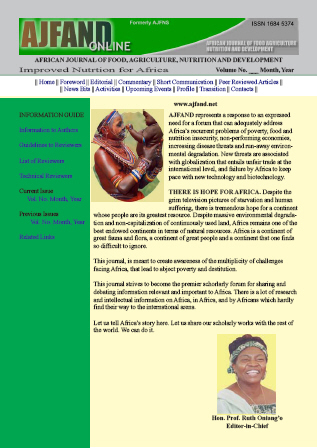
|
African Journal of Food, Agriculture, Nutrition and Development
Rural Outreach Program
ISSN: 1684-5358
EISSN: 1684-5358
Vol. 13, No. 5, 2013, pp. 8187-8208
|
 Bioline Code: nd13079
Bioline Code: nd13079
Full paper language: English
Document type: Research Article
Document available free of charge
|
|
|
African Journal of Food, Agriculture, Nutrition and Development, Vol. 13, No. 5, 2013, pp. 8187-8208
| en |
FIGHTING UNDERNUTRITION AND CHILD MORTALITY IN SIERRA LEONE
Bangura, Sheka
Abstract
This study has analysed the determinants of child undernutrition and mortality in
Sierra Leone with the objective of identifying key predictors to advise policy. It
utilises the country’s Demographic and Health Survey 2008. The estimation of the
empirical model employs a seemingly unrelated regression (SUR) technique and
probit framework. The predictors of undernutrition found most significant are:
mothers’ education; housing environment measured by household density,
accommodation capacity and sanitary condition; regional development
differentials; having vegetables in the diet for mothers and children; and
immunization. The predictors found significant for tackling mortality are:
mothers’ education; household density; recognition of gendered differential needs
for children; nutritional deficiency; micronutrient supplement; and postnatal care.
The policy simulations demonstrate that focusing policy on these factors could
immensely help address child growth problems in the country. More particularly,
the paper suggests the need for a greater focus on supporting mothers’ education
and strengthening public health in childcare management. That, while modern
medicine is always crucial, it can be perceived only as bolstering good natural
practices in caring for children. It is noted that children that are chronically
undernourished can resist episodic sources of undernutrition more strongly than
those that have not been undernourished before. This supports the argument that
while ‘vulnerability’ and ‘poverty’ are closely related concepts, they are separable
from a static and dynamic point of view; the former measures the probability of
becoming poor due to exposure to shocks even if one is currently better-off, or the
probability of becoming poorer for those that are already poor. Child wasting
appears closer to vulnerability than stunting, which is mainly noted with those
already in poverty. Therefore, policies should target both urban and rural
settlers—the former are characterised in this study by higher incidence of child
wasting (acute undernutrition) while the latter are characterised by higher
incidence of stunting (chronic undernutrition). The study does not find any strict
linearity in the expectation of the distribution and dynamics of the effects of
nutritional deficiency and morbid episodes across the socioeconomic groups
analysed, thereby evincing the need for careful policy targeting. The four regions
of the country should be evaluated carefully in policy targeting processes, given
that there are urban poverty pockets as well as rural poverty pockets.
Keywords
Undernutrition; Childcare; Cognitive Capacity; Productivity
|
| |
© Copyright 2013 - African Journal of Food, Agriculture, Nutrition and Development
Alternative site location: http://www.ajfand.net/
|
|
